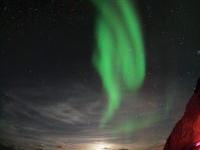For many years, scientists assumed the aurora seen around the north pole was identical to the aurora seen around the south pole. The poles are connected by magnetic field lines and auroral displays are caused by charged particles streaming along these field lines. Because the charged particles follow these field lines, it would make sense that the auroras would be mirror images of each other.
Heavens
WASHINGTON-(Jan. 25, 2019)-Mutations in a gene known as interferon regulatory factor 6 (IRF6) that cause cleft lip and palate also are implicated in neural tube defects such as spina bifida, suggests research by an international study team published online Jan. 25, 2019, in Human Molecular Genetics.
WASHINGTON (Jan. 17, 2019)--Gamma-ray bursts are the most powerful explosions in the cosmos. These explosions last several seconds and emit the same amount of light as nearly all the stars in the universe. Such extreme amounts of energy can only be released during catastrophic events like the death of a very massive star, and also produce visible supernovae or hypernovae, the latter being 5 to 50 times more energetic than supernovae.
New research led by astrophysicists at Durham University, UK, predicts that the Large Magellanic Cloud (LMC) could hit the Milky Way in two billion years' time.
The collision could occur much earlier than the predicted impact between the Milky Way and another neighbouring galaxy, Andromeda, which scientists say will hit our galaxy in eight billion years.
The catastrophic coming together with the Large Magellanic Cloud could wake up our galaxy's dormant black hole, which would begin devouring surrounding gas and increase in size by up to ten times.
Although helium is a rare element on Earth, it is ubiquitous in the Universe. It is, after hydrogen, the main component of stars and gaseous giant planets. Despite its abundance, helium was only detected recently in the atmosphere of a gaseous giant by an international team including astronomers from the University of Geneva (UNIGE), Switzerland. The team, this time led by Genevan researchers, has observed in detail and for the first time how this gas escapes from the overheated atmosphere of an exoplanet, literally inflated with helium. The results are published in Science.
Scientists at The University of Texas at Austin's Marine Science Institute have discovered nearly two dozen new types of microbes, many of which use hydrocarbons such as methane and butane as energy sources to survive and grow--meaning the newly identified bacteria might be helping to limit the concentrations of greenhouse gases in the atmosphere and might one day be useful for cleaning up oil spills.
For the first time astronomers have detected gravitational waves from a merged, hyper-massive neutron star. The scientists, Maurice van Putten of Sejong University in South Korea, and Massimo della Valle of the Osservatorio Astronomico de Capodimonte in Italy, publish their results in Monthly Notices of the Royal Astronomical Society: Letters.
Some things are so complicated that it is completely impossible to precisely calculate them. This includes large quantum systems, which consist of many particles, particularly when they are not in an equilibrium state, but changing rapidly. Such examples include the wild particle inferno that occurs in particle accelerators when large atoms collide, or in the early universe, just after the Big Bang, when particles rapidly expanded and subsequently cooled.
The Large Hadron Collider (LHC) at the European Organization for Nuclear Research (CERN)--operators of the world's largest particle physics lab--near Geneva, Switzerland, is said to be the largest particle accelerator in the world. The accelerator lies in a tunnel 27 kilometers in circumference, as deep as 175 meters beneath the French-Swiss border. This, by the way, has helped scientists uncover the Higgs boson, the last particle predicted by the Standard Model in 2012.
About 15 percent of breast cancers are classified as triple-negative, lacking receptors for estrogen, progesterone, and Her2. These cancers do not respond to targeted hormonal therapies, and they tend to be particularly aggressive, often resisting systemic chemotherapy and metastasizing to other tissues.
Taking advantage of observations from the Hubble Space Telescope, researchers provide evidence of what could be the first exomoon - a moon orbiting a planet outside our solar system. While the authors were rigorous in their evaluations, they caution that their results must be confirmed by subsequent work. Recently, NASA's Kepler space telescope surveyed for moons in a sample of 284 transiting planets - planets that pass between a star and an observer, resulting in a momentary dimming of the star's light.
A newly discovered fossil suggests that large, flowering trees grew in North America by the Turonian age, showing that these large trees were part of the forest canopies there nearly 15 million years earlier than previously thought. Researchers from Adelphi University and the Burpee Museum of Natural History found the fossil in the Mancos Shale Formation in Utah, in ancient delta deposits formed during a poorly understood interval in the North American fossil record.
New 3D maps of water distribution during cellular membrane fusion are accelerating scientific understanding of cell development, which could lead to new treatments for diseases associated with cell fusion. Using neutron diffraction at the Department of Energy's Oak Ridge National Laboratory, researchers have made the first direct observations of water in lipid bilayers used to model cell membrane fusion.
Astronomers from the Department of Physics at the University of Tokyo discovered a dense disk of material around a young star, which may be a precursor to a planetary system. Their research could vastly improve models of how solar systems form, which would tell us more about our own place in the cosmos.
A team of scientists led by researchers from the University of Hawai'i at Mānoa School of Ocean and Earth Science and Technology (SOEST) found the first direct evidence for the surface exposed water ice in permanently shaded regions (PSRs) of the Moon.
